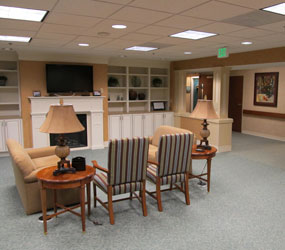As families investigate different levels of elder care available for loved ones, developing a day-to-day mental picture of a facility or type of care can be as important as the basic facts.
However, an image of assisted living, which falls between independent living and nursing care, can be difficult to conjure because of the wide variance of the needs – and therefore lifestyles – of its residents.
Assisted living facilities cater to those who now need help with the tasks of daily life – dressing and toileting, meal preparation, stimulating activities, medical appointments or medications – but don’t need skilled nursing care.
Residents may need help with all of these tasks or just a few. Memory-care assisted living offers services to those with these needs because of dementia or Alzheimer’s disease. Residents in general assisted living receive a lot of options about food, activities and schedules, based on their own needs and desires.
Residents of assisted living and their families work with staff to create an individualized service plan, which functions as a daily calendar and check list for staff.
“We like to give residents as much choice as possible within their service plan,” says Phil Golden, chief operating officer at Springwell Senior Living in Mount Washington. “Some service plans might say: ‘She hates to get up early. Needs a tray for breakfast.’ ”
Meals might include two or three entrée options along with multiple options for sides and desserts, served in a formal dining room, a café-like dining area or the resident’s room.
Activities, which vary daily, are offered after breakfast, lunch and dinner. They may be participatory, such as bridge, knitting or tai chi; social, such as happy hours or moderated current events discussions; entertainment, such as movie nights and professional singers; or a combination, such as sing-alongs led by a professional or karaoke.
Residents can also choose to go on field trips to restaurants or local attractions.
Those examples are all organized by staff, but activities might also be spontaneous or organized by residents – such as clubs, a game of pool or a nature walk.
“We try to do a lot with music because that seems to get everyone involved,” says Michael Willis, assistant administrator of Renaissance Gardens at Charlestown. “That and puppies and children are always popular.”
In fact, children and other visitors are always welcome, and some activities, such as ice cream socials, are even geared toward bringing in families.
“We don’t restrict times that a visitor can come,” Willis explains. “Residents can have visitors anytime. The family member can sleep on a cot or the couch in their room. We also have guest rooms they can use.”
While activities and visitors occupy residents, assisted living staff provide the services residents need in the “backdrop,” says Golden. That includes help with bathing and toileting, administering medications, cleaning, taking care of laundry, etc.
Also individuals may have their own “backdrop” activities that staff helps arrange transportation for, such as rehab, therapy, medical appointments, etc.
For those in memory care units, the structure of the day would be similar to other assisted living units, with activities interspersed between meals and personal and medical care going on in the background.
However the facility is secured and residents typically need more of the staff’s services. The type of activity would be geared toward stimulating long-term memory, which is typically better in these residents. For instance, an activity might be a slide show of antique cars.
Those in memory-care assisted living facilities do get less choice on a daily basis, simply because their decision-making capacity has diminished. But that doesn’t mean their desires aren’t taken into account.
Susan Push, director of Keswick Memory Care, explains, “We say ‘What did this person do when they were independent?’ We try to model that as much as possible.”
Families can help put together a menu of items the resident prefers. Residents are reminded and encouraged – but never pushed – to come to the activities offered.
“The goal is to be as close to home as we can but providing a cushion of safety,” says Push of memory-care facilities.
But the same could be said of all assisted living.


